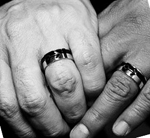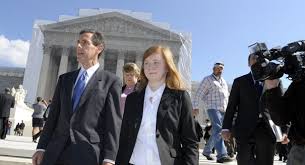Join Midwin live on Twitter every Monday for
where she answers your questions on legal careers, law school, entrepreneurship, women-owned businesses and how to transition careers! Follow @midwincharles on Twitter.
|
|
Midwin Charles spoke at the Urban Assembly School for Law and Justice's
Lunch with Lawyers.
April 16, 2013.
|
|
Midwin Charles was a panelist at The Haitian Times Step Into Your Power Women's Brunch on
March 16, 2013.
|
Design by 
|
|
 |
|
 George Zimmerman - MC&A has kept its readers up-to-date on the George Zimmerman case, most recently reporting on the story in our previous month's Sidebar. Since that time, Zimmerman's trial in the death of Trayvon Martin has come to a close with the 6-women jury returning a verdict of not guilty on both the second-degree murder and manslaughter charges. The verdict has rendered the nation divided, with those believing Zimmerman to be guilty calling for states across the country to re-evaluate their stand-your-ground laws so that a tragic death such as that of Trayvon Martin will never happen again. George Zimmerman - MC&A has kept its readers up-to-date on the George Zimmerman case, most recently reporting on the story in our previous month's Sidebar. Since that time, Zimmerman's trial in the death of Trayvon Martin has come to a close with the 6-women jury returning a verdict of not guilty on both the second-degree murder and manslaughter charges. The verdict has rendered the nation divided, with those believing Zimmerman to be guilty calling for states across the country to re-evaluate their stand-your-ground laws so that a tragic death such as that of Trayvon Martin will never happen again. |
June was all about the Supreme Court. In the span of three days, the nation's highest court handed down three major decisions that have the country reeling, raving and rejoicing.
|
|
DOMA No More
|  On June 26, 2013, the U.S. Supreme Court struck down the Defense of Marriage Act ("DOMA"). DOMA, enacted in 1996, barred the federal government from recognizing same-sex marriages, thereby preventing same-sex couples from receiving certain tax benefits. In a 5-4 vote, the Court held the federal act to be in violation of the Fifth Amendment to the U.S. Constitution. With DOMA out of the picture, same-sex couples whose home state allows same-sex unions will be entitled to the same federal tax benefits that their heterosexual counterparts qualify for. Under DOMA, homosexual spouses could not obtain tax-free health benefits from employers, could not file joint federal tax returns, and could not receive the federal marital deduction for inheritance taxes. The last issue - that of inheritance taxes for widows and widowers - was exactly what brought this case to the court's attention. Edie Windsor filed suit against the government when she received a tax bill of $360,000 from the IRS after Thea Spyer, who Windsor married in Canada in 2007, passed away. If the couple had been heterosexual, Windsor would not have been faced with such a hefty bill. The decision, authored by Justice Anthony Kennedy, ruled that DOMA unlawfully discriminated against same-sex couples. "The federal statute is invalid, for no legitimate purpose overcomes the purpose and effect to disparage and injure those whom the state, by its marriage laws, sought to protect in personhood and dignity. By seeking to displace this protection and treating those persons as living in marriages less respected than others, the federal statute is in violation of the Fifth Amendment," Justice Kennedy wrote. Kennedy was joined by the Court's liberal camp: Justices Ginsberg, Kagan, Sotomayor, and Breyer. Dissenting were the more conservative justices: Chief Justice Roberts and Justices Scalia, Thomas, and Alito. Between the four, three dissents were issued which all differed in rationale, but agreed that the portion of DOMA defining marriage as between a man and a woman was constitutional. Scalia's dissent echoed the same sentiment as his dissent written 10 years ago in the case of Lawrence v. Texas, a case in which the majority held a law banning gay sex to be unconstitutional. In his dissent, Scalia voiced concern that the failure to protect the traditional definition of marriage could create a slippery slope. "By formally declaring anyone opposed to same-sex marriage an enemy of human decency, the majority arms well every challenger to a state law restricting marriage to its traditional definition," he wrote. Gays and their supporters across the nation rejoiced upon hearing the Court's decision; this is a huge win for gay rights. However, the decision only tackled one section of DOMA. There still exists a valid section of the federal act, which shields states from recognizing same-sex marriages obtained in another state. The question now left open as a result - one which Justice Scalia pondered in his dissenting opinion - is what happens when a gay or lesbian couple marries in New York but then moves to Alabama? Can they file a joint tax return? This is something that the Obama administration will have to tackle in coming months. Sources: "Supreme Court Bolsters Gay Marriage With Two Major Rulings," by Adam Liptak, June 26, 2013, The New York Times; "Supreme Court strikes down Defense of Marriage Act," by Richard Wolf & Brad Heath, June 26, 2013, USA Today; "Supreme Court DOMA Decision Rules Federal Same-Sex Marriage Ban Unconstitutional," by Ryan J. Reilly & Sabrina Siddiqui, June 26, 2013, The Huffington Post |
 |
Re-Mapping the Voting Rights Act: It Might Have Residents Relocating
|  On June 25, 2013, the Supreme Court struck down a key provision of the Voting Rights Act in a 5-4 decision. That portion of the Voting Rights Act was a map laying out which states had to receive permission from the federal government prior to changing their voting laws. The map of the Voting Rights Act was created during the civil rights movement and targeted states with a history of voter discrimination. Those states - Alabama, Alaska, Arizona, Georgia, Louisiana, Mississippi, South Carolina, Texas and Virginia - can now freely make changes to voting procedures without federal clearance. Such changes include moving polling stations and redrawing electoral districts. In addition to the above-listed states, the law also applied to 12 cities and 57 counties outside those states. The Court's two sides were divided on the issue of whether minorities still face racism in the voting process in states with a history of racial discrimination. Writing for the majority was Chief Justice Roberts, who voiced the opinion that minority voters no longer face the barriers of their predecessors, citing in his ruling the difference in voter registration between 1965 and present day. For example, in Alabama, black voter registration in '65 was 19% versus 73% in 2004. Roberts stated in his opinion that Congress must draw a map indicative of current conditions. "Our country has changed," Roberts wrote. "While any racial discrimination in voting is too much, Congress must ensure that the legislation it passes to remedy that problem speaks to current conditions . . . If Congress had started from scratch in 2006, it plainly could not have enacted the present coverage formula." Justice Ginsberg pointed out in her dissent that while the Voting Rights Act has certainly aided minority voters in breaking down racial barriers at the polls, it has not yet eradicated those barriers. Voters now face issues such as racial gerrymandering - issues that the Act has effectively thwarted. Justice Ginsberg would prefer to defer to Congress. In her dissent, Ginsberg wrote, "When confronting the most constitutionally invidious form of discrimination, and the most fundamental right in our democratic system, Congress' power to act is at its height . . . The court errs egregiously by overriding Congress' decision." The Voting Rights Act was first passed in 1956 by President Lyndon Johnson. Since being signed into law, Congress has renewed the act 4 times, most recently in 2006 where it passed in the Senate unanimously. With the Supreme Court's decision, Congress now faces the task of redrawing that map - a job many believe will be a tedious process given the sharply divided state of Congress. As for how the ruling will effect voters now, we can expect to see some changes in voting laws in some of those states. Texas announced almost immediately following the decision that it would enforce a voter identification law that had previously been blocked. Until Congress can get its act together and come to an agreement on a new map based on current conditions, voters will likely see new laws popping up across the south. Sources: "Supreme Court Invalidates Key Part of Voting Rights Act," by Adam Liptak, june 25, 2013, The New York Times; "Supreme Court strikes down part of Voting Rights Act," by Pete Williams & Erin McClam, June 25, 2013, nbcnews.com; "Supreme Court Strikes Down Key Part of Voting Rights Act," by Ariane De Vogue, Terry Moran, & Abby D. Phillip, June 26, 2013, abcnews.com
|
No Action for Affirmative Action
|
 On June 24, 2013, the Supreme Court handed down its decision in the affirmative action case of Fisher v. University of Texas at Austin. The decision the Court reached? Not to make a decision at all. The Court instead remanded the case back to a federal appeals court with the directive that the court apply the highest standard of legal scrutiny: strict scrutiny. What, exactly, does that mean? Strict scrutiny will require the university to prove that the means used to obtain diversity within its school walls are narrowly tailored to serve that goal. Writing the opinion for the Court, Justice Kennedy stated, "Strict scrutiny imposes on the university the ultimate burden of demonstrating, before turning to racial classification, that available, workable race-neutral alternatives do not suffice." Under this level of scrutiny, the onus is on the university to prove that applicants are evaluated as individuals as a whole, with race being one of many features as opposed to being the defining feature in deciding whether to accept the applicant as a future student. The case first came about when Abigail Noel Fisher sued the University of Texas at Austin in 2008 when she was denied admission. Fisher's suit claimed that the school's admission policy violated her equal protection rights, arguing she was rejected because she is white, while less-qualified minority applicants were accepted into the university's program. Under affirmative action, public universities are allowed to consider race as a factor when making admissions decisions so as to create a more diverse student body. UT Austin uses a holistic admissions process in which all students who graduate in the top 10 percent of their high school classes are automatically accepted into the university. The school only considers race as a factor for those applicants who do not qualify under the 10 percent rule. Fisher was one of those students who fell outside the top 10 percent of their class. The Fifth Circuit Court of Appeals originally upheld the university's admissions policy of considering race as a factor in making admissions decisions. In applying the new level of scrutiny, it is possible that the court will reach the same conclusion. Bill Powers, president of the university, believes that the school will meet that higher standard. "We remain committed to assembling a student body at The University of Texas at Austin that provides the educational benefits of diversity on campus while respecting the rights of all students and acting within the constitutional framework established by the court," he stated. The Court's decision came in a 7-1 vote, with only Justice Ginsberg dissenting. Justice Kagan recused herself due to having formerly been involved with the case. Justice Thomas joined the majority, but authored his own opinion stating that the consideration of race in college admissions violates equal protection. In his view, discrimination is discrimination, whether seemingly benefitting minority groups or not. "Although cloaked in good intentions, the university's racial tinkering harms the very people it claims to be helping," wrote Thomas. Meanwhile, Justice Ginsberg opined in her dissent that the lower court used the appropriate level of review in coming to its decision. She wrote, "Government actors need not be blind to the lingering effects of an overtly discriminatory past. I have said before and reiterate here that only an ostrich could regard the supposedly neutral alternative as race unconscious. We will have to wait and see what decision the Fifth Circuit reaches with its new required level of scrutiny, but based upon the Supreme Court's ruling, affirmative action still has a place in admissions processes. Sources: "High Court Says Police Can Collect Sources: "Supreme Court sidesteps big ruling on Texas affirmative action," by Bill Mears, June 24, 2013, cnn.com; "Supreme Court raises bar for affirmative action in college admissions," by Pete Williams & Erin McClam, June 24, 2013, nbcnews.com; "Fisher v. University of Texas At Austin: Supreme Court Rules On Affirmative Action Case," by The Huffington Post, June 24, 2013, The Huffington Post |
|
|